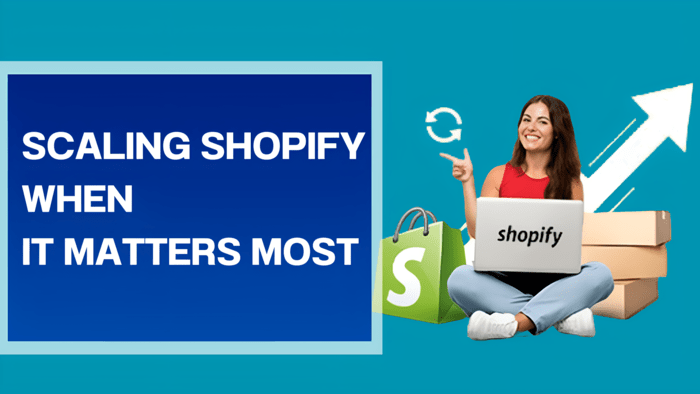What happens when your best sales moment becomes your biggest liability? You launch a holiday campaign, invest in paid traffic, and suddenly – your Shopify store slows, glitches, or worse, crashes. According to a 2023 Adobe report, retailers lose up to 35% of potential revenue due to performance issues during peak shopping periods. That’s not just missed opportunity. It’s money walking out the door.
The real issue? Most Shopify brands are built to survive day-to-day operations but not to thrive under pressure. And without a purpose-built Shopify infrastructure for scale, stores buckle under the very success they work so hard to earn.
I’ve seen this happen more than once. And the truth is: scaling Shopify during peak seasons isn’t about fancy features or vanity metrics. It’s about engineering your store to stay fast, flexible, and fail-proof – no matter how much traffic hits.
Let’s dive into the best practices for scaling Shopify during peak season, with strategies that prioritize performance, resilience, and growth.
No Performance, No Conversions
Peak traffic is a stress test. Slow page loads, broken carts, or clunky UX get magnified tenfold. Shoppers aren’t patient, especially on mobile. Google found that 53% of users abandon sites that take more than 3 seconds to load.
Optimizing for speed and uptime is foundational to any Shopify infrastructure for scale. That means compressing images, lazy-loading non-essential content, minimizing app bloat, and critically partnering with developers who understand Shopify’s limitations and workarounds.
Here’s the kicker: performance issues don’t just kill conversions – they spike support tickets, tank ROAS, and frustrate internal teams. Fixing them before they break means building faster, cleaner storefronts with a mobile-first mindset, efficient codebase, and minimal third-party drag.
One example? A skincare brand we worked with shaved 1.2 seconds off load time by consolidating scripts, replacing heavy apps with theme-native logic, and deferring non-critical JavaScript. Result? 17% bump in mobile conversions without increasing ad spend.
Don’t Just Use Shopify – Engineer It to Scale
Shopify Plus isn’t just a badge. It unlocks infrastructure-level tools that support scale. You get:
- Shopify Functions for custom checkout logic
- Shopify Flow for automation
- Shopify Launchpad to schedule campaigns
- Checkout Extensibility for personalized flows without code hacks
But here’s where many brands stall: they stop at Plus and assume the job’s done. Truth is, Shopify gives you the rails, but you still have to lay the track. This means smart caching layers, queue systems for big syncs (especially with ERPs or PIMs), and fallback mechanisms during API rate limits.
If you’re syncing inventory from multiple systems, set up middleware that doesn’t choke under load. At Frontlevels, we often build a custom logic layer to handle catalog syncs during peak hours – buffering inventory, validating data, and ensuring Shopify gets clean inputs without latency.
Don’t rely on out-of-the-box setups to handle edge cases like flash sales, pre-orders, or gated launches. Architect for resilience.
You wouldn’t go live on Black Friday without testing your checkout flow but too many brands treat “stress testing” like a nice-to-have. It’s not.
Simulate traffic spikes. Run mock product drops. See how your store handles 5x your average traffic. Use load testing tools like Loader.io or k6 to mimic real-world scenarios.
And don’t forget your integrations. Make sure your Shopify theme, apps, email automations, and backend systems all fire without delay or duplication. One common bottleneck? Email marketing tools that trigger multiple flows for a single customer action due to sync delays.
I always advise running a full dry-run one month before your biggest campaign. This allows you to flag broken logic, test backup flows, and prepare for real behavior – not just ideal conditions.
Scaling doesn’t always mean more visitors. Often, it means squeezing more from your existing traffic. That’s where advanced segmentation and conversion-based personalization come in.
With tools like Shopify Audiences or Klaviyo’s predictive analytics, you can identify high-intent segments and tailor campaigns around them. Combine this with dynamic product recommendations, real-time social proof, and localized messaging to lift AOV and retention, without increasing ad budget.
Example: one fashion brand used predictive scoring to retarget mid-funnel users with urgency-based bundles (limited stock, sizes running low). Their peak conversion rate jumped from 3.8% to 5.6%, with no extra spend.
This is the kind of strategy that turns a flat season into a record quarter. Build smarter journeys, not louder ads.
Middleware: The Backbone of Scalable Shopify Ops
As your catalog, integrations, and complexity grow, point-to-point app setups start to collapse. This is where middleware becomes essential to Shopify infrastructure for scale.
Middleware acts as the logic brain between systems: your PIM, ERP, 3PL, marketplaces, and Shopify store. It cleans data, syncs intelligently, and prevents those critical “why is this product out of stock on the site but in-stock in our ERP?” moments.
Signs you need middleware:
- 1,000+ SKUs with variants or bundles
- Frequent catalog sync issues or support tickets
- Manual workarounds to fix tags, images, or descriptions
- Multiple storefronts or languages
We built a custom middleware solution for a consumer electronics brand running multiple EU storefronts. They reduced sync errors by 90% and launched new SKUs 60% faster, all during their busiest season.
Don’t wait until your store breaks. Middleware is the quiet enabler that makes scaling smooth, not stressful.
Align Ops and Marketing: Launch With Precision

Here’s a hard truth: most Shopify stores don’t fail at peak because of traffic or tech. They fail because operations and marketing aren’t aligned.
Your ops team needs to know campaign timelines, inventory levels, expected surges, and fulfillment cutoffs. Your marketing team needs clarity on stock, variant readiness, and promotions before a campaign goes live.
Use shared dashboards. Set up pre-launch checklists. Automate status alerts across Slack, Notion, or ClickUp. When everyone operates from a single source of truth, you catch issues before they cost you sales.
One of our clients uses Shopify Flow to trigger alerts when high-performing SKUs drop below threshold, allowing their paid team to pause campaigns instantly. That’s the level of coordination that scales.
Plan for Recovery Before You Need It
Even the best systems can wobble. What separates resilient brands is their recovery plan.
- Back up key product and theme data before peak days
- Use a status page to communicate outages or delays
- Pre-write fallback campaigns and apology sequences
- Set up alerts for 404 spikes, cart errors, and payment failures
I’ve seen brands recover from 20-minute outages without losing a single customer because they were prepared with real-time comms, fast rollback plans, and proactive messaging.
Peak season is unforgiving. Don’t just prep your tech – prep your team, messaging, and customer touchpoints too.
Final Thoughts: Scaling Is Mindset, Not Just Tech
If your Shopify store is constantly teetering between “barely keeping up” and “almost breaking,” it’s time to think beyond survival.
Scaling successfully isn’t about chasing traffic or adding more tools. It’s about refining the Shopify infrastructure for scale that underpins your operations, personalizing the experience for the customers you already have, and using smart tech – like middleware – to create a seamless backend.
When you build for scale, peak season stops being stressful. It becomes predictable, profitable, and dare I say – fun.
At Frontlevels, we help fast-growing Shopify brands unlock that next stage with a full-stack strategy: performance, ops, and data all speaking the same language. If you’re gearing up for growth and want your store to hold strong under pressure, we’re here to help.


